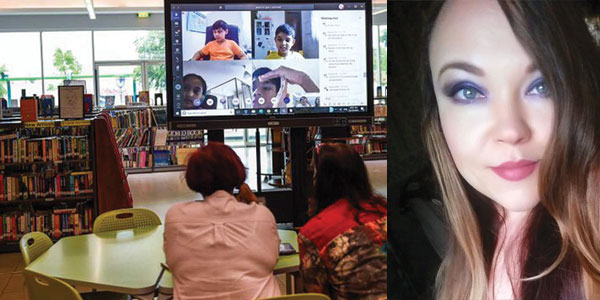
By Chara
Teachers are considered our guides while we grow up and help us through different stages. They teach us new things, understand us and provide guidance. As many other members of the society, teachers are also struggling because of the COVID-19 pandemia and they are trying to find ways to help all their students.
Melissa Lackey, a Warrensburg, Mo., resident & teacher said the pandemia has changed the way she teaches. “I teach ESOL [English for Speakers of Other Languages] students. Many are fairly new to the country and do not speak English well. My job has changed from teacher of English to teacher of “how-to-survive-online-learning. Instead of normal lessons, I do daily check-ins with my students in which they have to respond to a question or writing prompt in a short sentence or short paragraph (in their native language if necessary) that essentially is designed to let me know how they are doing and how I can help them,” Lackey said.
During the pandemia Lackey has found help in technology. “I’ve learned that technology is incredibly important,” she said.
Lackey uses an app called Talking Points to communicate with families from different backgrounds and she uses screen recording videos to teach their students how to use technology to complete their lessons. “Talking Points allows two-way communication that is automatically translated. This has helped me get some students connected online and explain to parents what is going on,” Lacked said.
The most challenging part of Lackey’s job is is getting students to connect to the internet and do their job.”It seems that I have students in three groups: those who think this is an extended vacation and take advantage of the time to stay up late and not do work, those who have limited English and need and request a significant amount of support, and those who have now taken on the responsibilities while parents work or while they are sick of babysitting, cooking, cleaning, doing many household chores, and working more hours themselves,” Lackey explained.
As and advise to parents, Lackey asks them to Relax. “Parents shouldn’t feel the need to teach their students from 8 am until 3:30 like a normal school day. Also, kids are resilient. This is not going to set them back in their education. Teachers are ready and prepared to close any gap that might come next school year,” Lackey said.
Susan Velsor, a teacher in Connecticut has also been affected by the COVID-19 pandemia.
“Teaching now looks totally different, I teach to a computer instead of students. As a special ed teacher so much of my instruction was hands on and incorporated movement or manipulative now I have to try and find a way to convey these approaches through the computer,” Velsor said.
Velsor misses the interactions with her students and to see them grow.
To get her lessons ready, Velsor records herself and finds material that will help their students. “I teach a math class so it takes so much more time to show out the work for equations step by step using a program such as google slides than it would if I could walk through it step by step with students on the board. I would say it takes me at least twice as long to get materials and lessons ready,” Velsor said.
Although many parents are overwhelmed with all the things that are going on, Velsor advises to set a time limit and encourage students to do the best they can and work hard.
“If your child is struggling contact the teacher because we really are trying to make this the best we can for student success,” Velsor said.
____________________________________________________________________________________________________________
Maestros sufren durante la pandemia del COVID-19
Como otros profesionales, los maestros están sufriendo debido a la pandemia del COVID-19.
Un desafío que los maestros enfrentan es encontrar maneras de ayudar a sus estudiantes, como lo atestigua Melissa Lackey. La residente y maestra de Warrensburg, Missouri, pasa clases para estudiantes que están aprendiendo inglés como segunda lengua. Muchos acaban de llegar a Estados Unidos, dijo.
Agregó que la pandemia ha cambiado la forma en la que Lackey enseña.
“Mi trabajo ha cambiado de maestra de inglés a maestra de ‘cómo sobrevivir el aprendizaje en línea’”, dijo. “En lugar de las lecciones normales, hago registros diarios con mis alumnos, en los que tienen que responder a una pregunta o escribir rápidamente en una oración corta o un párrafo corto (en su idioma nativo si es necesario) que esencialmente está diseñado para permitirme saber cómo están y cómo puedo ayudarlos”.
Durante la pandemia, Lackey ha “aprendido que la tecnología es increíblemente importante”, dijo. Específicamente, Lackey utiliza una aplicación llamada Talking Points para comunicarse con familias de diversos orígenes. También usa videos de grabación de pantalla para enseñar a los estudiantes cómo usar la tecnología para completar sus lecciones.
“Talking Points permite una comunicación bidireccional que se traduce automáticamente”, dijo Lackey. “Esto me ha ayudado a conectar a algunos estudiantes en línea y explicar a los padres lo que está sucediendo”.
La parte más desafiante del trabajo de Lackey es lograr que los estudiantes se conecten a Internet y hagan su trabajo, dijo.
“Parece que tengo estudiantes en tres grupos: aquellos que piensan que estas son vacaciones extendidas y aprovechan el tiempo para quedarse despiertos hasta tarde y no trabajar, aquellos que tienen un inglés limitado y necesitan y piden una cantidad significativa de apoyo, y aquellos que ahora han asumido las responsabilidades (de crianza) mientras (sus) padres trabajan o cuando están cansados de cuidar niños, cocinar, limpiar, hacer muchas tareas domésticas y trabajar más horas ellos mismos”.
Susan Velsor, maestra de Connecticut, también ha sido afectada por el COVID-19.
“La enseñanza ahora luce totalmente diferente”, dijo Velsor. “Enseño a una computadora en lugar de a los estudiantes. Como maestra de educación especial, gran parte de mi instrucción era práctica e incorporaba movimientos o acciones (manipulativas). Ahora, tengo que tratar de encontrar una manera de transmitir estos enfoques a través de la computadora”.
Para preparar sus lecciones, Velsor se graba y encuentra material que ayudará a sus alumnos a aprender en línea.
“Enseño una clase de matemáticas, por lo que lleva mucho más tiempo mostrar el trabajo de ecuaciones paso a paso usando un programa como las diapositivas de Google de lo que lo haría si pudiera recorrerlo paso a paso con (los) estudiantes en la pizarra”, dijo. “Diría que me toma al menos el doble de tiempo el preparar (los) materiales y lecciones”.
Velsor extraña las interacciones con sus alumnos y verlos crecer, dijo.
Al igual que los maestros, muchos padres con niños en edad escolar se sienten abrumados. Velsor aconseja a los padres que establezcan límites de tiempo y alienten a sus hijos a hacer lo mejor que puedan y trabajar duro.
“Si su hijo tiene dificultades, comuníquese con el maestro porque realmente estamos tratando de hacer esto lo mejor posible para el éxito de los estudiantes”, dijo Velsor.









